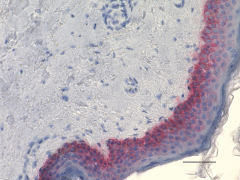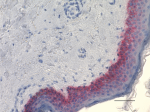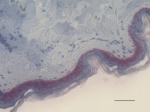- Clone
- AE-1 (See other available formats)
- Regulatory Status
- RUO
- Isotype
- Mouse IgG1, κ
- Ave. Rating
- Submit a Review
- Product Citations
- publications

-

IHC staining of purified anti-Cytokeratin antibody (clone AE-1) on formalin-fixed paraffin-embedded human skin tissue. Following antigen retrieval using Retrieve-All Antigen Unmasking System 1: Universal, 100X (Cat. No. 927901), the tissue was incubated with 0.5 µg/ml of the primary antibody for 20 minutes at room temperature. A biotinylated anti-mouse linking reagent followed by alkaline phosphatase conjugated streptavidin and fast red chromogen was used for detection. Hematoxylin was used for counterstaining, according to the protocol provided. The image was captured with a 40X objective. Scale bar: 50 µm -

IHC staining of purified anti-Cytokeratin antibody (clone AE-1) on formalin-fixed paraffin-embedded dog skin tissue. Following antigen retrieval using Retrieve-All Antigen Unmasking System 1: Universal, 100X (Cat. No. 927901), the tissue was incubated with 0.5 µg/ml of the primary antibody for 20 minutes at room temperature. A biotinylated anti-mouse linking reagent followed by alkaline phosphatase conjugated streptavidin and fast red chromogen was used for detection. Hematoxylin was used for counterstaining, according to the protocol provided. The image was captured with a 40X objective. Scale bar: 50 µm -

IHC staining of purified anti-Cytokeratin antibody (clone AE-1) on formalin-fixed paraffin-embedded primate skin tissue. Following antigen retrieval using Retrieve-All Antigen Unmasking System 1: Universal, 100X (Cat. No. 927901), the tissue was incubated with 0.5 µg/ml of the primary antibody for 20 minutes at room temperature. A biotinylated anti-mouse linking reagent followed by alkaline phosphatase conjugated streptavidin and fast red chromogen was used for detection. Hematoxylin was used for counterstaining, according to the protocol provided. The image was captured with a 40X objective. Scale bar: 50 µm
| Cat # | Size | Price | Quantity Check Availability | Save | ||
|---|---|---|---|---|---|---|
| 914004 | 100 µg | 229 CHF | ||||
This antibody recognizes low and intermediate molecular weight type I acidic keratins (40, 48, 50, and 56.5 kD). This clone stains the basal layer of epidermis and most epithelia.
Product DetailsProduct Details
- Verified Reactivity
- Human
- Reported Reactivity
- Dog, Non-Human Primate
- Antibody Type
- Monoclonal
- Host Species
- Mouse
- Immunogen
- This antibody was developed using human epidermal keratins.
- Formulation
- Phosphate-buffered solution, pH 7.2, containing 0.09% sodium azide.
- Preparation
- The antibody was purified by affinity chromatography.
- Concentration
- 0.5 mg/ml
- Storage & Handling
- The antibody solution should be stored undiluted between 2°C and 8°C.
- Application
-
IHC-P - Quality tested
- Recommended Usage
-
Each lot of this antibody is quality control tested by formalin-fixed paraffin-embedded immunohistochemical staining. For immunohistochemistry, a concentration range of 0.5 - 5.0 µg/ml is suggested. It is recommended that the reagent be titrated for optimal performance for each application.
-
Application References
(PubMed link indicates BioLegend citation) -
- Yang K, et al. 1990. Amer. J. of Clin. Path. 94:261. (IHC) PubMed
- RRID
-
AB_2616958 (BioLegend Cat. No. 914004)
Antigen Details
- Biology Area
- Cell Biology, Cell Motility/Cytoskeleton/Structure, Neuroscience, Neuroscience Cell Markers
- Molecular Family
- Intermediate Filaments
- Gene ID
- NA
- UniProt
- View information about Cytokeratin on UniProt.org
Related Pages & Pathways
Pages
Related FAQs
Other Formats
View All Cytokeratin Reagents Request Custom Conjugation| Description | Clone | Applications |
|---|---|---|
| Purified anti-Cytokeratin | AE-1 | IHC-P |
Compare Data Across All Formats
This data display is provided for general comparisons between formats.
Your actual data may vary due to variations in samples, target cells, instruments and their settings, staining conditions, and other factors.
If you need assistance with selecting the best format contact our expert technical support team.
 Login / Register
Login / Register 










Follow Us